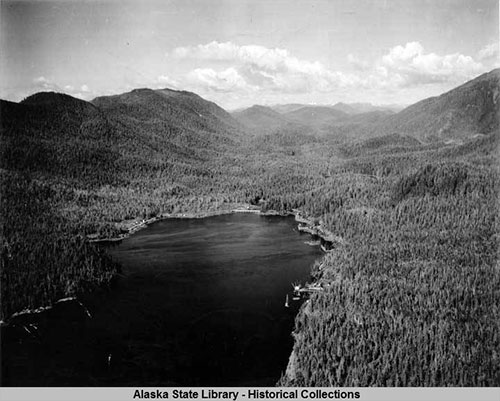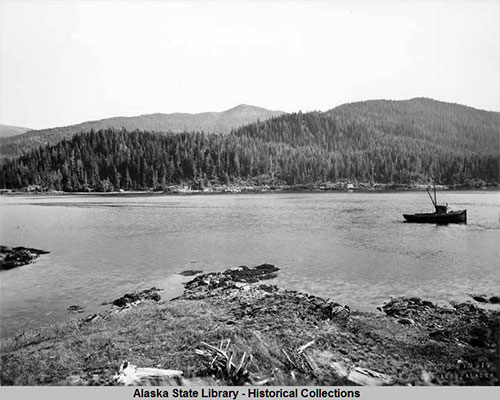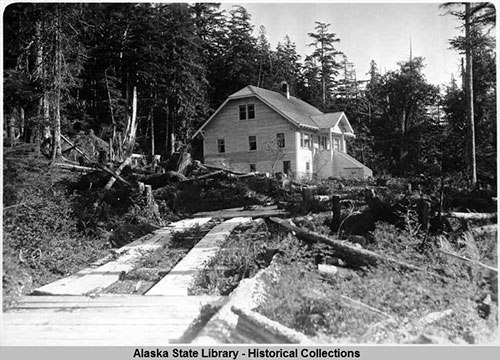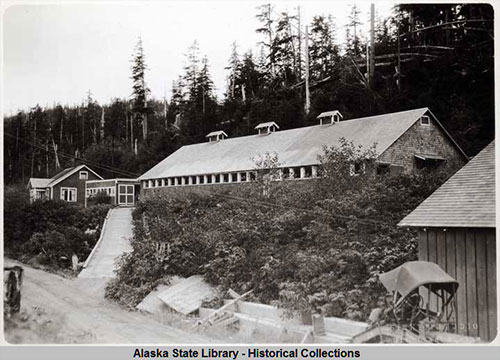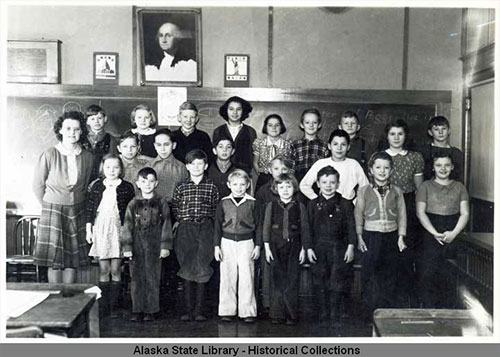Ward Cove has been Ketchikan economic engine for 100 yearsCruise ship port would redevelop pulp mill siteBy DAVE KIFFER November 29, 2019
Ward Cove has been home to a cannery, the pulp mill, numerous smaller businesses and even a town that sought to supplant Ketchikan as the main community in the area. Ward Cove also comes with a built-in mystery. Just who the heck was "Ward?"
No one knows exactly. In the 1960s and 70s, regional historian and Alaska place names expert Bob DeArmond spent a fair amount of time trying to determine where the name came from. He was more successful at debunking theories. He first determined that the "Dictionary of Alaska Place Names" was incorrect in determining the name came from the US Coast Survey of the early 1880s. Place Names said "Ward" was one of the officers on the USS Patterson that surveyed the area, but DeArmond found the ship had no such officer. DeArmond also investigated the claim that it was a misspelling of the name "Waud"" after W.W. Waud who had a salmon saltery in the area from 1883 to 1892. But DeArmond determined that the name "Ward's Cove" predated the saltery. DeArmond wrote in "Names on the Chart" that it had been likely named after a Hudson's Bay employee back in 1879, when HMS Osprey stopped in the cove.
From the early days, Ward Cove was prized as one of the best natural anchorages in Southeast Alaska. It is interesting to think how Ketchikan would have developed differently if the community had begun in Ward Cove and the Ward Lake/Lake Harriet Hunt drainage with all its flat land, as opposed to the narrow, rocky shoreline along Ketchikan Creek. Several American survey missions used Ward Cove as bases of operations in the 1880s and 1890s. While those missions were undergoing, steamships such as the Ancon and the Idaho stopped in the cove to provision the surveys, creating some of the first economic activity in Ward Cove. Besides Waud's, another saltery was based in Ward Cove. Henry Imhoff opened the facility in 1896. Imhoff's daughter would later marry Eugene Wacker, another important name in Ward Cove history. In 1901, William Connell opened the Alaska Fish and Mining Company in the cove. It failed, as did an effort for a third saltery owned by T.L. Foster.
Meanwhile, former Territorial Governor August P. Swineford had hatched a plan for his own town in Ward Cove, the city of Revilla. (See "Revilla Hoped to Eclipse Ketchikan," SITNEWS, July 31, 2009). At the time, Ketchikan and Loring were battling to be the location of the custom house for Southern Southeast Alaska. All ship traffic entering Alaska from Dixon Entrance was required to stop at the custom house and whichever city that had it would likely become the dominant city in the region. Swineford, also the publisher of Ketchikan's first newspaper - the Mining Journal, offered a third option with Revilla, located in the best harbor in the area. Swineford even got the government to set up a post office in Revilla, He wasn't the only one to see potential in the cove. The Pacific Coast Steamship Company had also built a small wharf in the cove. When federal fishery official Jefferson Moser visited the area in 1898, he noted that besides the steamer wharf and the post office, the community had a handful of stores and several dwellings. There was also a sawmill owned by William Harper and the Revilla Hotel and Restaurant. Development taking place in both Loring and Ketchikan proved a ready market for the sawmill which supplied both of the Revilla's competitors. Unfortunately for Revilla, and Loring, the government finally chose Ketchikan as the customs house site. More than anything, that act solidified Ketchikan's future as the primary community in the region for the next century. Revilla had ceased to exist as a separate town by 1902. The sawmill continued to operate for several more years, under the management of William Connell and later J.R. Heckman. During this time, Ward Cove was accessed by boats. But prelimary efforts had begun to build a "pioneer" road the five miles between Ketchikan and Ward Cove. It would be completed in 1924. In 1912, the Walsh-Moore Canning Company opened a cannery in the cove. In 1914, it was renamed the Ward Cove Packing Company. In 1928, the cannery was purchased by W.A. and H.A. Brindle and eventually grew into Columbia-Wards Fisheries, one of the large canning companies in Alaska. The Wards Cove Packing plant cranked out 150,000 cases of salmon per year and was one of Ketchikan largest employers for decades before it finally closed in 2004. Meawhile, a second "community" had sprung up on the opposite side of Ward Cove. Eugene Wacker, a German immigrant who was related to the Chicago family that Wacker Driver was named after, came to Ketchikan in 1912 and staked an 160-acre homestead site in Ward Cove. He married Henry Imhoff's daughter Lillian. He too recognized Ward Cove's potential and saw it as a location that was superior to Ketchikan due to the deep water port. By 1919, "Wacker" city had a small school and had taken over the post office that had been located in Revilla. Wacker plotted a townsite and even sold several of the lots. He attempted to incorporate the community as a second class city, but was not successful. In 1924, the "road" reached the cannery. Wacker built a small ferry to carry people and supplies across the cove to Wacker City. Wacker began a bus service connecting Ketchikan and Wacker which would operate until 1946. In the early 1920s, another business opened in Ward Cove. It was locally called "The Stink Plant." Officially, the Ward Cove Reduction Plant took the inedible parts of fish carcasses and turned them into products such as soap, fertilizer and edible animal meal. The reduction plant would operate off and on - in a variety of forms - until the mid 1950s.
Also in the 1920s, dry weather spawned a series of "forest fires" that damaged many of the buildings in Wacker and also extended as far north as the Totem Bite area. Many of the burnt tree stumps and dead trees on the hillsides of Ward Cove date from this period. In 1940, the cove received began receiving visitors from the "future." Pan American Airways had begun investigating whether amphibious Clipper airplane service made sense to Southeast Alaska in 1938 with flights from Seattle to Ketchikan and Juneau. (See "Pan Am: Once Ketchikan's Link to the Outside World," SITNEWS, Dec, 29, 2006). After two years, the airline moved its operations from the crowded Downtown Ketchikan waterfront to Ward Cove. There was no land airfield in the Ketchikan area at that point, and the Clippers were Ketchikan's only long distance air option. But - with war looming - Pan Am suspended the service in 1940, choosing instead to fly land planes directly to Juneau from Seattle. During the War, a land airfield was built on Annette Island and Pam Am - and other airlines - would use that field to access the Ketchikan area until the 1970s. Wacker - who was born in 1878 - would live until 1957, his village never usurping Ketchikan. But he lived long enough to see his property turn into the community's biggest economic engine, the Ketchikan Pulp Company.
A change in federal law in 1947 allowed for the long-term timber contracts that made construction of large pulp mills in the region economically feasible. By early 1950, the American Viscose Corporation and Puget Sound Pulp and Timber Company had joined together to form KPC and purchase 96 acres on the Wacker homestead. Construction of the $40 million dollar pulp mill would begin in 1952 and the mill would open in 1954. It operated until 1997, employing more than 500 workers year round. It has been more than two decades since the Pulp Mill closed (See "Ketchikan Pulp Company Closed 20 Years Ago," SITNEWS, Mar. 22, 2017), and a variety of small businesses have continued to operate in the cove, with most of the old mill location going unused. But last June, the Ward Cove Group announced a plan to build a $50 million cruise ship terminal in Ward Cove that would service two of the larger cruise ships at a time. There are also plans to eventually redevelop the mill site with shops and other tourism related businesses. Norwegian Cruise Lines has signed a 30-year agreement with the Ward Cove Group and Fairbanks based Godspeed Inc for preferential berthing at the new facility. Permitting is currently taking place. WCG hopes to have the facility operating by July of 2020.
On the Web:
Contact Dave at dave@sitnews.us Dave Kiffer ©2019 Publication fee required. © Representations of fact and opinions in comments posted are solely those of the individual posters and do not represent the opinions of Sitnews.
|
||||||||

